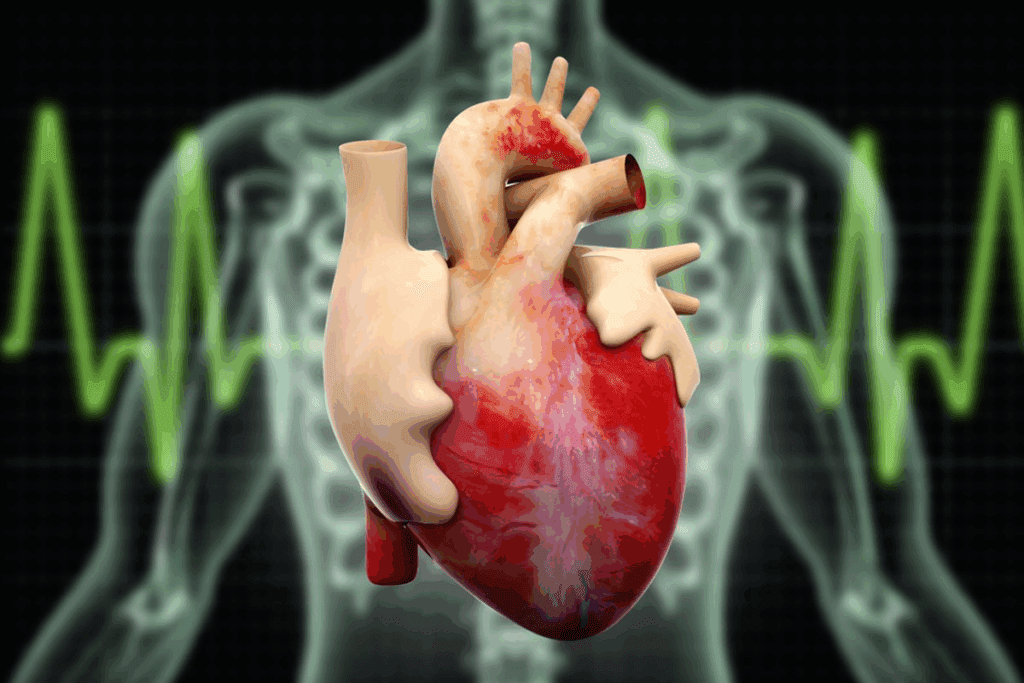Last Updated on October 31, 2025 by Batuhan Temel

Explore angina treatment with 7 best medications to relieve chest pain effectively.
At Liv Hospital, we know that chest pain can really hurt your daily life. Angina, or reduced blood flow to the heart, causes chest discomfort. We aim to give you relief from chest pain with different medicines.
We work hard to manage symptoms and stop heart problems. We look at the best chest pain medications and heart pain meds for you. Knowing about angina types and treatments helps us tailor care for you.

Knowing about angina is key to managing it well. Angina is a sign of heart trouble, often from coronary heart disease. It shows as chest pain or discomfort when the heart muscle doesn’t get enough oxygen-rich blood.
Angina pain usually comes from less blood flow to the heart muscle. This often happens because of coronary artery disease. The arteries narrow or block due to plaque buildup.
Other things like hard work, stress, extreme weather, or big meals can also cause it. When the heart muscle doesn’t get enough oxygen, it hurts or feels uncomfortable in the chest, arms, neck, jaw, or back. This pain means the heart is working too hard to get oxygen.
It’s important to know the signs of angina to get help fast. Common symptoms include:
These symptoms can change in how bad they are and how long they last. Angina symptoms can be unpredictable and may change over time.
There are several types of angina, each with its own features:
| Type of Angina | Description |
| Stable Angina | Predictable chest pain or discomfort that occurs with exertion or stress and is relieved by rest or medication. |
| Unstable Angina | Unpredictable chest pain that can occur at rest, is more severe, or lasts longer than usual. It is a sign of a possible heart attack. |
| Microvascular Angina | Chest pain caused by dysfunction of the tiny blood vessels in the heart. |
| Prinzmetal Angina | Chest pain caused by a spasm in the coronary arteries, often occurring at rest. |
Knowing the type of angina you have is important for the right treatment. Doctors often use medications like nitrates, beta-blockers, and calcium channel blockers. These help manage symptoms and lower the risk of serious problems.

Managing angina needs a mix of medicine and lifestyle changes. It’s not just about easing symptoms. It’s also about stopping problems and making life better.
We have short-term and long-term goals for treating angina. Short-term goals are to ease symptoms and avoid quick problems. Long-term goals are to make angina happen less often and slow down heart disease.
For quick relief, nitroglycerin is key. For long-term care, we use a mix of medicines like beta-blockers and lifestyle changes. These include diet, exercise, and quitting smoking.
Knowing when to get emergency help is important. If chest pain lasts more than a few minutes or is very bad, get help fast. Also, seek help if pain is different or doesn’t get better with medicine.
Medicines are key in managing angina. They help with pain and prevent heart attacks. They also lower the risk of dying from heart disease.
| Medication Type | Primary Use | Examples |
| Nitrates | Relieve acute angina symptoms | Nitroglycerin, Isosorbide |
| Beta-Blockers | Reduce heart rate and blood pressure | Metoprolol, Atenolol |
| Calcium Channel Blockers | Relax blood vessels and reduce heart workload | Amlodipine, Diltiazem |
Knowing about different medicine for chest pain and chest pain medication helps us manage angina better. This improves patient results.
Nitrates are key in treating sudden chest pain attacks. They offer quick relief. These medicines have been around for decades to help with angina, a condition causing chest pain due to heart blood flow issues.
Nitrates release nitric oxide, which relaxes blood vessel muscles. This makes blood vessels wider, easing heart work and boosting heart muscle blood flow. They help by lowering heart oxygen needs and increasing supply, easing angina symptoms.
There are many nitrate medicines for angina. The most common are:
How you take nitrates depends on the type and form. For quick relief, sublingual nitroglycerin is used. It dissolves under the tongue for fast action. For prevention, longer-acting nitrates like isosorbide are taken by mouth. Always follow your doctor’s dosage advice to get the most benefit and avoid side effects.
Nitrates are usually safe but can have side effects. Common ones include headaches, dizziness, and flushing. Serious but rare side effects include low blood pressure and methemoglobinemia. To safely use nitrates, stick to the dosage and tell your doctor about all medications you’re taking. Some, like erectile dysfunction drugs, can dangerously interact with nitrates.
Beta-blockers are key in treating angina. They help by lowering the heart’s need for oxygen. This is vital in managing chronic stable angina, easing symptoms by slowing the heart rate and reducing its strength.
Beta-blockers block the hormone epinephrine’s effects. They also slow the heart rate and lessen its workload. This action cuts down the heart’s oxygen need, reducing angina episodes.
Several beta-blockers are used for angina, like Metoprolol, Atenolol, and Carvedilol. Each type can lower heart rate and oxygen demand, though they differ slightly.
| Medication | Dosage Range | Frequency |
| Metoprolol | 50-200 mg | Once or twice daily |
| Atenolol | 25-100 mg | Once daily |
| Carvedilol | 3.125-25 mg | Twice daily |
Beta-blockers do more than just treat angina. They help with high blood pressure, heart failure, and survival after a heart attack. They reduce heart strain, boosting overall heart health.
While mostly safe, beta-blockers can cause fatigue, dizziness, and cold hands or feet. They’re not for everyone, like those with severe asthma or certain heart issues. Always talk to your doctor about your health history.
Calcium channel blockers are key in treating angina. They help by making blood flow better to the heart. These drugs relax heart and blood vessel muscles, making it easier for blood to flow and reducing heart work.
These blockers stop calcium from entering heart and blood vessel muscles. This makes arteries wider, improving blood flow and lowering blood pressure. The heart gets more oxygen, leading to fewer and less severe angina attacks.
There are many types of calcium channel blockers, each with its own benefits. Some common ones include:
Calcium channel blockers are great for those who can’t take beta-blockers or have certain health issues. They’re also good for managing coronary artery spasms.
While mostly safe, calcium channel blockers can cause side effects like dizziness, headaches, and swelling in the legs. Adjusting the dose or switching to another type might help. Regular check-ups with a doctor are key to avoiding problems and getting the most benefits.
Antiplatelet agents are key in stopping complications for angina patients. They stop blood clots in arteries, lowering heart attack and stroke risks. Knowing how they work helps patients manage their angina better and live better lives.
Antiplatelet agents are vital in treating angina. They stop platelets from clumping, which reduces heart attack and stroke risks. Using them right can greatly improve patient outcomes and cut down on the need for more serious treatments.
Aspirin and clopidogrel are top choices for angina patients. Aspirin is popular because it stops platelets from clumping well. It’s given in small doses to avoid side effects. Clopidogrel blocks platelet activation and is used when aspirin isn’t an option or with aspirin for extra protection.
Getting the right dose of antiplatelet agents is key for safety and effectiveness. Aspirin doses for angina range from 75 to 325 mg daily, with 81 mg being common. Clopidogrel starts with a loading dose followed by a regular dose. It’s vital to follow your doctor’s advice on dosage and how to take it.
While antiplatelet agents are safe and effective, there are risks. They can increase bleeding risk, which is a concern for surgery or bleeding disorders. Regular check-ups with your doctor are needed to weigh the benefits against the risks.
Statins are key in managing angina long-term. They protect against heart problems. These drugs are vital for those with angina, as they lower cholesterol and stop artery plaque.
Statins block the enzyme HMG-CoA reductase. This enzyme is important for liver cholesterol production. By stopping cholesterol production, statins reduce artery cholesterol, lowering heart risk.
Key benefits of statins for angina sufferers include:
Statins do more than manage angina. They greatly improve heart health. They lower heart event risk, improving life quality for those with heart disease.
It’s essential to note that while statins are generally well-tolerated, they can have side effects. Common side effects include muscle pain, liver enzyme elevation, and increased diabetes risk. Yet, most patients find the benefits worth the risks.
Several statins are used for angina management. These include:
Each statin has its benefits and side effects. The right choice depends on the patient’s angina severity, health, and drug interactions.
Safe statin use requires regular checks. Liver function tests and muscle damage signs are monitored. Patients should report any side effects to their doctor.
Understanding statins and their heart benefits helps angina patients manage their condition. This reduces their risk of heart events.
For those who don’t get relief from usual angina treatments, ranolazine is a new option. It’s made to help manage chest pain in angina patients.
Ranolazine boosts blood flow to the heart, cutting down on angina episodes. It doesn’t change heart rate or blood pressure much. Instead, it improves the heart’s efficiency by reducing the late sodium current in cardiac muscle cells. This lowers the heart’s oxygen demand.
Ranolazine is for patients with chronic angina who haven’t found relief with other meds. It’s often paired with other treatments to boost their effect. A healthcare provider decides if ranolazine is right for you based on your condition and medical history.
Studies show ranolazine helps reduce angina episodes in those who didn’t respond to other treatments. It improves exercise tolerance and cuts down on nitroglycerin use. This makes life better for these patients.
Ranolazine is usually safe but can cause side effects like dizziness, headache, and nausea. Rare but serious side effects include QT interval prolongation, which needs watching. Patients with liver or kidney disease might need special care or dosage adjustments.
It’s key to follow your doctor’s advice and report any side effects or worries. This way, you can get the most out of ranolazine while avoiding risks.
Combination therapy is becoming more important in treating angina. It uses several medications to tackle different parts of angina. This can lead to better control of symptoms and better results for patients.
Using more than one drug can help manage angina in many ways. It lets doctors use lower doses of each medication, which can reduce side effects. It also targets different parts of angina, making treatment more complete.
For example, mixing a beta-blocker with a calcium channel blocker works well. Beta-blockers slow the heart and reduce muscle contraction. Calcium channel blockers widen blood vessels, easing the heart’s workload.
There are several common combinations used in treating angina. These include:
Doctors choose the right mix based on each patient’s needs and health history.
| Medication Combination | Primary Benefits |
| Beta-blocker + Nitrate | Reduces heart rate and oxygen demand; gives quick relief from angina symptoms |
| Calcium Channel Blocker + Nitrate | Causes blood vessels to widen, lowers blood pressure; boosts oxygen supply to the heart |
| Beta-blocker + Calcium Channel Blocker | Reduces oxygen demand and improves heart function |
Personalizing treatment is essential in managing angina. We consider the patient’s health, any other health conditions, and the type of angina they have. This helps us choose the right medications and doses.
For example, patients with certain health issues may need special care with their medications. Those with diabetes, for instance, need to be closely watched when taking certain drugs.
It’s important to regularly check how well the treatment is working. This involves:
By carefully managing combination therapy, we can improve treatment results for patients with angina. This helps them live better lives and reduces the risk of serious problems.
Managing angina well means finding the right treatment for each person. We looked at many medicines for chest pain relief. These include nitrates, beta-blockers, and more.
Doctors look at many things to choose the best medicine. They consider the patient’s health, how bad the chest pain is, and other heart issues. Knowing about different medicines helps patients and doctors create a plan that works.
The aim is to find the best medicine or mix of medicines. This helps ease chest pain and keeps side effects low. If you have chest pain, talk to your doctor. They can help find the best treatment for you.
Common treatments for angina include nitrates, beta-blockers, and calcium channel blockers. Antiplatelet agents and statins are also used. These help manage chest pain and prevent heart problems.
Nitrates widen blood vessels. This improves blood flow to the heart. It also reduces the heart’s workload, easing chest pain.
Beta-blockers slow the heart rate and reduce its workload. They also lower blood pressure. This helps lessen angina episodes and improves heart health.
Calcium channel blockers are used when beta-blockers don’t work. They’re also good for certain types of angina, like variant angina.
Antiplatelet agents, like aspirin, prevent blood clots. This reduces the risk of heart attacks and other heart problems in angina patients.
Statins lower cholesterol levels. This reduces the risk of heart events and improves heart health in angina patients.
Ranolazine treats angina that doesn’t respond to other treatments. It improves blood flow to the heart and reduces angina episodes.
Combination therapy uses multiple medications for better symptom control. It reduces heart risks and improves life quality for angina patients.
Managing side effects requires working closely with your doctor. Follow the dosage and report any issues. Your doctor may adjust your treatment.
The best medications vary based on the cause and severity of chest pain. Nitrates, beta-blockers, and calcium channel blockers are common choices.
Work with your doctor to find the right treatment. Monitor your symptoms and adjust your treatment as needed.
National Center for Biotechnology Information. (2025). Angina Treatment 7 Best Medications for Chest Pain. Retrieved from https://www.ncbi.nlm.nih.gov/pmc/articles/PMC7747969/
Subscribe to our e-newsletter to stay informed about the latest innovations in the world of health and exclusive offers!
WhatsApp us